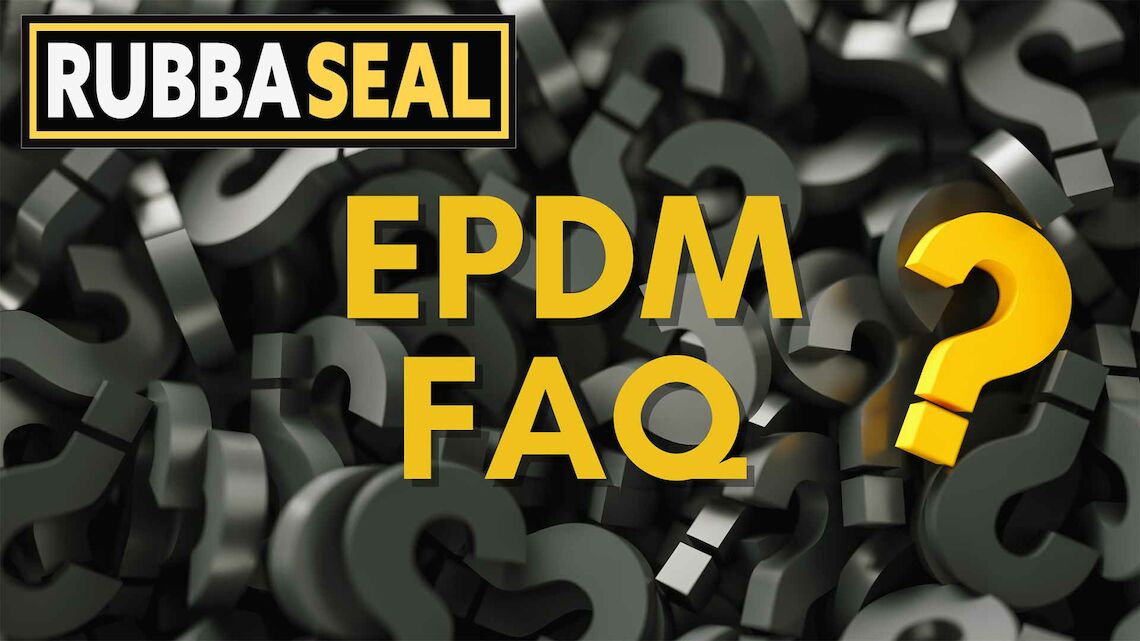

There are 0 items in your cart |
on orders over £350 ex VAT
free downloadable warranty
Encrypted With SSL

We always get asked questions about our EPDM membrane, and in this blog post, we have answered the top 25 questions we get posed to us. Below are our most answered questions, along with no-nonsense answers to make sure you’ve got all the information you need when working with EPDM.
EPDM stands for Ethylene Propylene Diene Monomer and is a synthetic rubber that was developed in the early 1960s.
EPDM has a lifespan of over 50 years, with roofing applications from the 1970s still going strong today.
EPDM roofing is a durable roofing solution which outperforms many of its rivals in areas such as UV resistance, weatherproofing and overall durability, making it a fantastic pick as a roofing material.
Although you can walk on an EPDM roof, the EPDM membrane is designed to take light foot traffic during installation and maintenance; heavy foot traffic is not recommended as this could damage the membrane and compromise the protective qualities of the roofing system.
Walkway pads can be added if you require this functionality & assuming the deck is specified appropriately.
EPDM is applied to a roof deck using water-based or contact spray adhesives.
EPDM has fantastic water resistance, though as houses shift over time, water may begin pooling, owing to changes to the roof's structure. It is important to drain any puddles/pools of water which may be appearing on the roof to remove the risk of stress on the EPDM membrane.
EPDM has a host of beneficial properties, including its durability to weather and UV, and is also a much simpler installation than other flat roofing systems such as felt. In some cases, EPDM may appear to be more expensive than a felt-based system, however, the cost over time is usually much lower.
It is not wise to install any roof covering in the rain as the deck itself will become wet and the retained moisture can cause problems. It is best to wait for a dry spell but, even with the best planning, the weather can turn unexpectedly. The advantage with EPDM (assuming you’ve not started the process of applying the glue), is that you find yourself with a suitably sized piece of rubber, which you can use as a tarpaulin. You can call a time-out and come back to it later! Many other systems don’t provide that benefit and if it starts to rain during the process, the job might be completely ruined and will have to be started all over again, with much of your roofing material going to waste.
EPDM can be installed directly onto the roof deck. We always recommend that our EPDM membrane is installed on a suitable deck, e.g. OSB or plywood. View our installation guides for full installation instructions.
Completing a DIY EPDM installation is possible, and we provide several installation videos & helpful guides to prepare you for a full installation.
By using a strong contact adhesive, you can adhere EPDM to brick.
It is not recommended to install a new EPDM roof over an existing EPDM installation, as condensation can build between the layers which can lead to the adhesive failing over time.
Our 1.2mm membrane is fine for most applications. In some more exposed situations, or if the roof is going to be subject to a degree of foot traffic, it might be more appropriate to go for the heavier grade 1.52mm membrane.
EPDM can be coated with specialist paint, however, precautions should be taken to ensure the roof is clean and free from debris before painting.
EPDM is a 100% waterproof material when installed correctly, and will not allow any moisture to be absorbed by the roof deck.
EPDM can be installed in temperatures above 5 degrees Celsius. Attempting an installation below this temperature will result in the water-based adhesive not creating a solid bond between the EPDM and the roof deck.
Although EPDM is fantastic at resisting both weather and UV damage, it is susceptible to damage caused by debris or repeated foot traffic.
The life expectancy for an EPDM rubber roof is 50+ years.
EPDM can be damaged over time by debris or repeated foot traffic. Damage can also be caused by roof tiles or heavy branches hitting the EPDM and leaving tears/punctures. However, these can be repaired quite easily.
EPDM has fantastic UV resistance properties and suffers minimal damage when exposed to sunlight for long durations. EPDM roofing is purpose-built for external applications and has a life expectancy of 50+ years.
Bubbles under the EPDM membrane can form during installation if a roller is not used to release trapped air whilst the membrane is being laid. Bubbles can be avoided by rolling out the area as the adhered membrane is applied to the roof deck. However, if bubbling does occur, it will not affect the integrity of the roof.
EPDM has a fantastic life span, however, if the roof deck remains saturated after maintenance and repairs have taken place, it may be time to replace the EPDM membrane.
The properties of EPDM's synthetic rubber mean it achieves a level of fire resistance. Our EPDM membrane is BROOF (T4) certified, showing its fantastic fire-resistance qualities.
There is no need to coat an EPDM roof. EPDM has a fantastic resistance to weathering, UV and water, and does not require any additional coating to form an effective barrier.

Click on our friendly RoofBot to help you work out what you need for your DIY TRC - Techno Rubber project, just input your dimensions, answer some simple questions and let RoofBot do the rest. If you still need assistance, don't hesitate to contact us at info@rubba-seal.co.uk or 01494 461711.
© 2024 Avenir Roofing Ltd t/a Rubba-Seal • All rights reserved
Registered in England and Wales: 04710777 •
VAT registration number: 527 2382 48